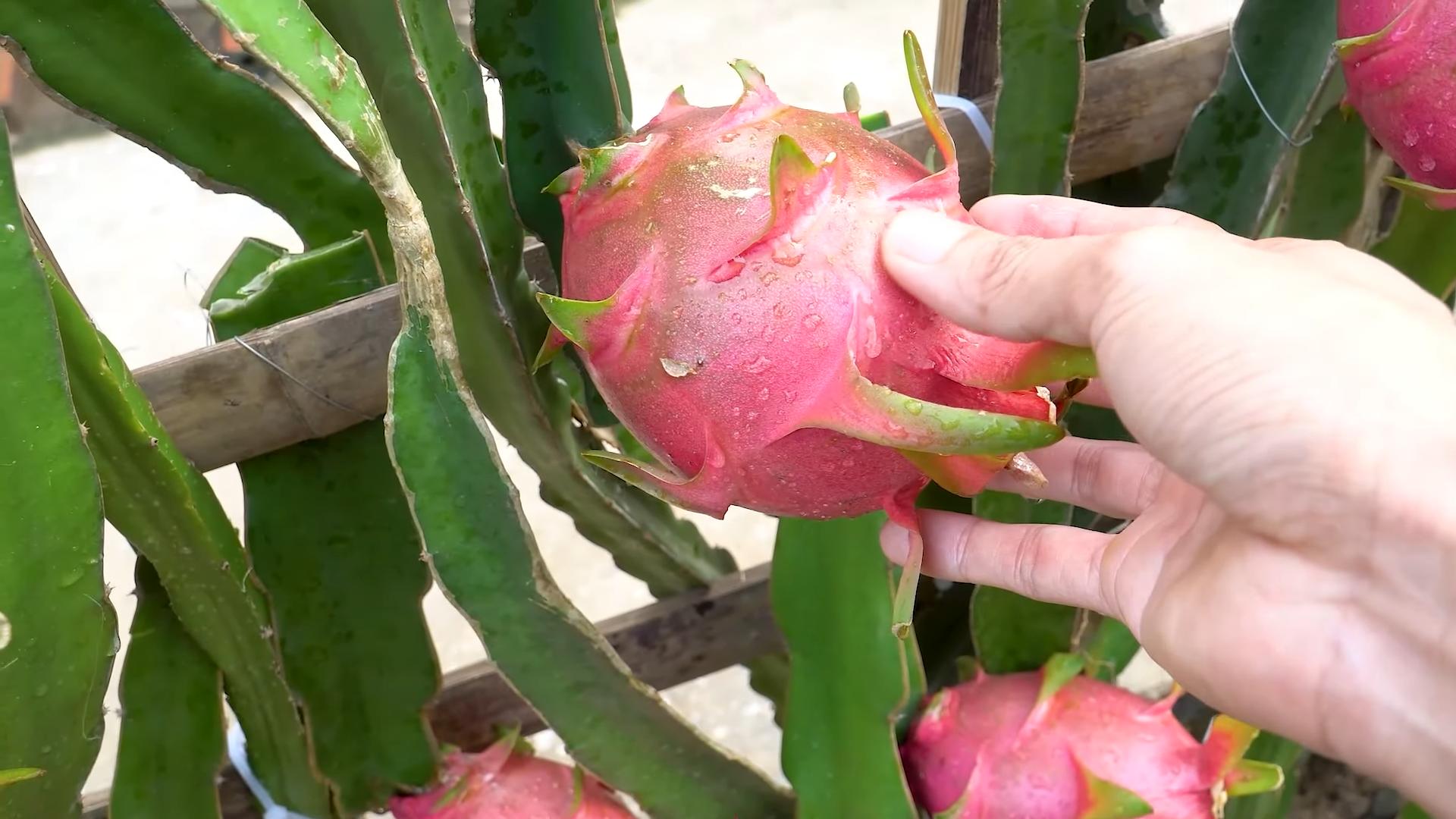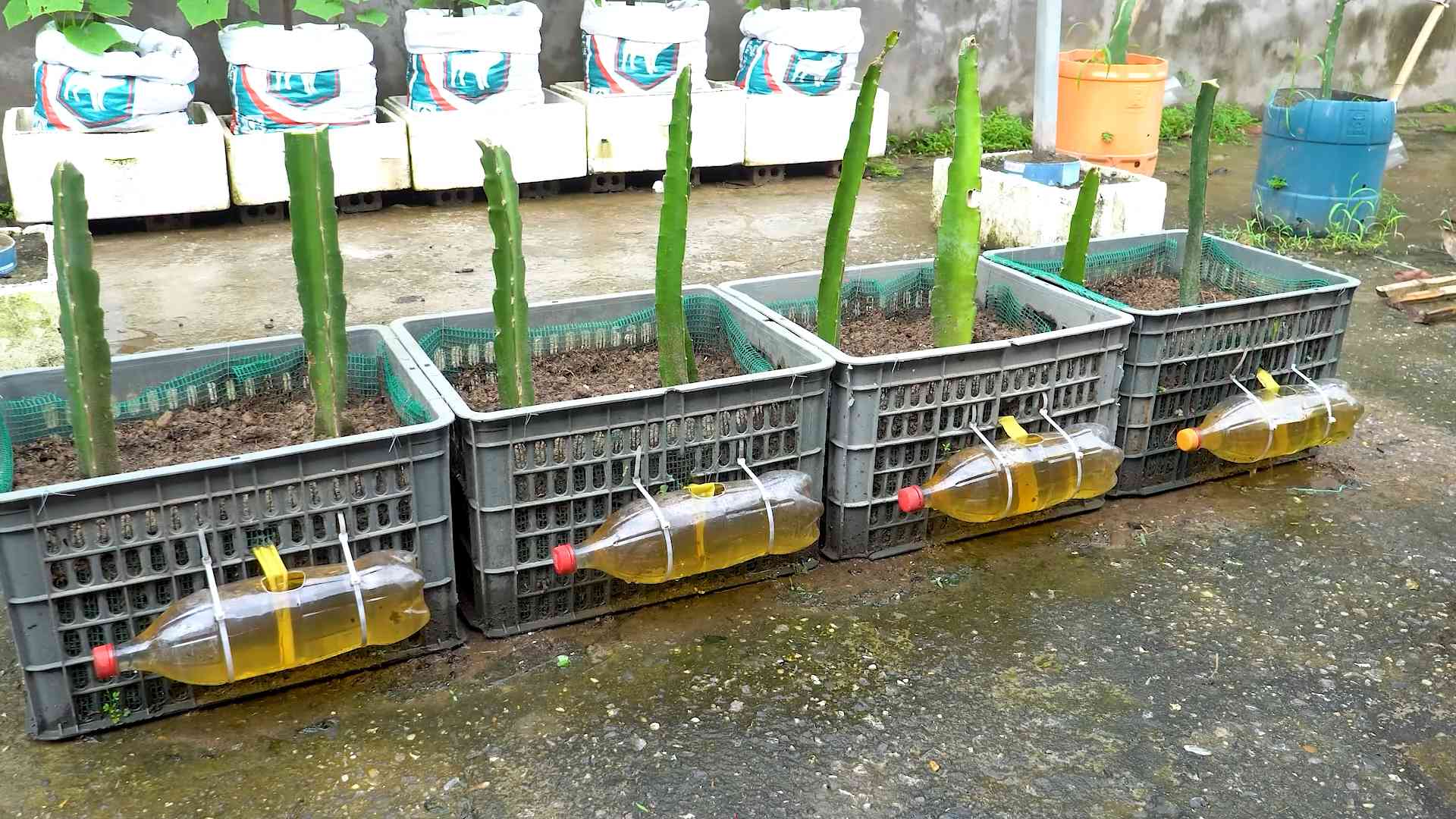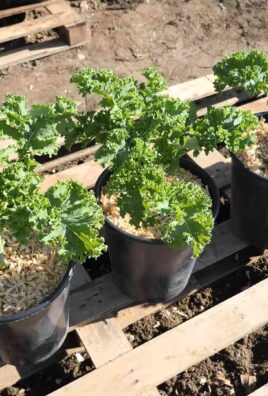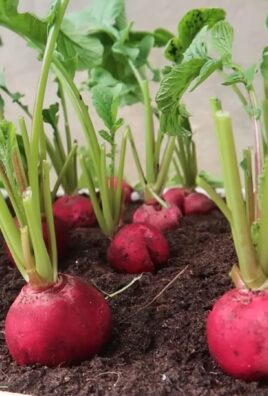Growing Dragon Fruit Indoors might seem like an exotic dream reserved for tropical climates, but I’m here to tell you it’s absolutely achievable, even if you’re miles away from the equator! Forget those expensive supermarket runs for this vibrant, delicious fruit. Imagine plucking your own dragon fruit, bursting with flavor, right from your living room.
For centuries, dragon fruit, also known as pitaya, has been cultivated in Southeast Asia and Latin America, prized not only for its unique taste but also for its stunning appearance. Its vibrant colors and otherworldly shape have made it a symbol of prosperity and good fortune in many cultures. But you don’t need a sprawling orchard to enjoy this treasure.
In today’s world, where access to fresh, healthy produce is increasingly important, learning how to cultivate your own food is empowering. Growing Dragon Fruit Indoors offers a fantastic way to connect with nature, reduce your carbon footprint, and enjoy a truly unique and rewarding gardening experience. Plus, let’s be honest, who wouldn’t want to impress their friends with their very own homegrown dragon fruit? This DIY guide will provide you with simple, step-by-step instructions and insider tips to successfully cultivate these beautiful plants within the comfort of your home. Get ready to embark on a fun and fruitful journey!

Growing Dragon Fruit Indoors: A Comprehensive DIY Guide
Hey there, fellow plant enthusiasts! Ever dreamt of having your own exotic dragon fruit, but live in a climate that’s, shall we say, less than tropical? Well, dream no more! I’m here to guide you through the surprisingly achievable process of growing dragon fruit indoors. It’s a rewarding experience, and trust me, that first homegrown dragon fruit will taste like pure victory.
What You’ll Need: The Dragon Fruit Starter Kit
Before we dive in, let’s gather our supplies. This is crucial for a smooth and successful dragon fruit journey.
* Dragon Fruit Cutting or Seedling: You can find these online, at nurseries, or even from a friend who already grows dragon fruit. Cuttings are generally faster to fruit.
* Large Pot (at least 20 gallons): Dragon fruit are climbers and need space for their roots to spread. A big pot is essential!
* Well-Draining Potting Mix: Cactus mix or a blend of potting soil, perlite, and sand works wonders. Drainage is key to prevent root rot.
* Trellis or Support Structure: These guys are climbers! A sturdy trellis, a tomato cage, or even a repurposed ladder will do the trick.
* Grow Lights (optional, but highly recommended): Especially if you live in a region with limited sunlight, grow lights will be your best friend.
* Watering Can or Hose: For, you know, watering.
* Pruning Shears: To keep your dragon fruit plant in shape.
* Fertilizer (Cactus or All-Purpose): To give your plant the nutrients it needs.
* Spray Bottle: For misting.
* Gloves: Dragon fruit can have small spines, so protect your hands.
Phase 1: Planting Your Dragon Fruit
Okay, let’s get our hands dirty! This is where the magic begins.
1. Prepare the Pot: Fill your large pot with the well-draining potting mix, leaving a few inches of space at the top.
2. Plant the Cutting or Seedling:
* For Cuttings: If you’re using a cutting, let the cut end callous over for a few days before planting. This helps prevent rot. Plant the cutting about 2-3 inches deep in the soil.
* For Seedlings: Gently remove the seedling from its container and loosen the roots a bit. Plant it at the same depth it was in the original container.
3. Install the Support Structure: Place your trellis or support structure in the pot, making sure it’s sturdy and well-anchored. You want it to be able to support a mature dragon fruit plant.
4. Water Thoroughly: Water the newly planted dragon fruit until water drains out of the bottom of the pot. This helps settle the soil and get the roots started.
5. Positioning: Place your pot in a location that receives at least 6-8 hours of sunlight per day. If you don’t have enough natural light, supplement with grow lights.
Phase 2: Nurturing Your Dragon Fruit Plant
Now that your dragon fruit is planted, it’s time to give it the TLC it needs to thrive.
1. Watering: Dragon fruit prefer to dry out slightly between waterings. Water thoroughly when the top inch or two of soil feels dry to the touch. Avoid overwatering, as this can lead to root rot. In the winter, you’ll need to water less frequently.
2. Fertilizing: Feed your dragon fruit plant with a cactus fertilizer or a diluted all-purpose fertilizer every 2-4 weeks during the growing season (spring and summer). Reduce or stop fertilizing during the winter months.
3. Light: Dragon fruit need plenty of light to grow and fruit. If you’re growing indoors, supplement with grow lights, especially during the winter. Aim for 6-8 hours of light per day.
4. Temperature: Dragon fruit prefer temperatures between 65°F and 80°F (18°C and 27°C). Avoid exposing them to temperatures below 50°F (10°C).
5. Humidity: Dragon fruit like humidity, but they can tolerate relatively dry air. You can increase humidity by misting the plant regularly or placing a tray of water near it.
6. Pruning: Pruning is important for shaping your dragon fruit plant and encouraging fruit production. Remove any dead or damaged branches. You can also prune to control the size and shape of the plant. The best time to prune is after the plant has finished fruiting.
7. Training: As your dragon fruit plant grows, you’ll need to train it to climb the support structure. Gently tie the stems to the trellis or support structure using soft twine or plant ties.
Phase 3: Encouraging Flowering and Fruiting
This is the exciting part! Getting your dragon fruit to flower and produce fruit takes a little patience and effort.
1. Maturity: Dragon fruit plants typically need to be at least 2-3 years old before they start to flower and fruit.
2. Pollination: Most dragon fruit varieties are self-pollinating, but cross-pollination can increase fruit set and size. If you have multiple dragon fruit plants, you can hand-pollinate them by transferring pollen from one flower to another using a small brush.
3. Nighttime Temperatures: Dragon fruit flowering is often triggered by a drop in nighttime temperatures. A slight temperature difference between day and night can encourage flowering.
4. Watering During Flowering: Be careful not to overwater during flowering, as this can cause the flowers to drop. Water only when the soil is dry to the touch.
5. Fertilizing During Flowering: Continue to fertilize your dragon fruit plant during flowering, but use a fertilizer that is high in phosphorus and potassium. These nutrients are important for flower and fruit development.
6. Patience: It can take several months for dragon fruit to mature after flowering. Be patient and don’t harvest the fruit until it is fully ripe.
Phase 4: Harvesting Your Dragon Fruit
The moment you’ve been waiting for! Harvesting your own dragon fruit is a truly rewarding experience.
1. Ripeness: Dragon fruit are ripe when the skin turns a bright, even color (usually red or pink, depending on the variety) and the “wings” or scales on the fruit start to dry out and turn brown. The fruit should also feel slightly soft to the touch.
2. Harvesting: To harvest the fruit, simply cut it from the stem using pruning shears. Leave a small piece of the stem attached to the fruit.
3. Storage: Dragon fruit can be stored at room temperature for a few days or in the refrigerator for up to a week.
Troubleshooting: Common Dragon Fruit Problems
Even with the best care, you might encounter a few challenges along the way. Here are some common problems and how to address them:
* Root Rot: This is usually caused by overwatering. Make sure your potting mix is well-draining and avoid watering too frequently. If you suspect root rot, repot the plant in fresh soil and remove any rotten roots.
* Pests: Dragon fruit can be susceptible to pests such as mealybugs, aphids, and scale. Inspect your plant regularly and treat any infestations promptly with insecticidal soap or neem oil.
* Lack of Flowering: If your dragon fruit plant isn’t flowering, it could be due to a lack of light, insufficient nutrients, or improper watering. Make sure your plant is getting enough light, fertilize it regularly, and water it properly.
* Fruit Drop: Fruit drop can be caused by a variety of factors, including overwatering, underwatering, lack of pollination, or temperature fluctuations. Try to identify the cause and adjust your care accordingly.
* Sunburn: While dragon fruit love sunlight, they can get sunburned if exposed to intense, direct sunlight, especially when young. Provide some shade during the hottest part of the day.
Choosing the Right Dragon Fruit Variety for Indoors
While most dragon fruit varieties can be grown indoors with proper care, some are better suited for container gardening than others. Here are a few popular choices:
* ‘Haley’s Comet’: This self-pollinating variety is known for its sweet, pink-fleshed fruit.
* ‘American Beauty’: Another self-pollinating option with vibrant pink flesh and a slightly tart flavor.
* ‘Sugar Dragon’: This variety produces smaller, sweeter fruit and is well-suited for smaller spaces.
* ‘Voodoo Child’: A unique variety with dark red flesh and a rich, complex flavor.
Remember to research the specific needs of the variety you choose to ensure optimal growth and fruiting.
Final Thoughts
Growing dragon fruit indoors might seem daunting at first, but with a little

Conclusion
So, there you have it! Growing dragon fruit indoors might seem like an exotic endeavor reserved for seasoned gardeners, but with a little patience, the right setup, and this simple DIY trick, you can absolutely cultivate these vibrant, delicious fruits right in your own home. We’ve walked you through the essentials, from selecting the right variety and providing adequate light to ensuring proper support and mastering the art of hand-pollination.
But why is this DIY approach a must-try? Because it empowers you to take control of your dragon fruit journey. You’re not relying on expensive, pre-made solutions or complex systems. You’re building a thriving environment tailored specifically to your plant’s needs, fostering a deeper connection with the growing process, and ultimately, reaping the rewards of fresh, homegrown dragon fruit. Plus, it’s incredibly satisfying to nurture a plant from a small cutting to a fruit-bearing beauty!
Beyond the Basics: Exploring Variations
Don’t be afraid to experiment! Once you’ve mastered the fundamentals, consider exploring different variations to personalize your indoor dragon fruit garden.
* Trellis Designs: Get creative with your trellis! Instead of a simple stake, try building a small, decorative trellis using bamboo or repurposed materials. This can add a touch of visual appeal to your indoor garden.
* Soil Amendments: While the recommended soil mix works well, you can experiment with adding other amendments like worm castings or compost tea to further enrich the soil and boost your plant’s growth.
* Lighting Options: If you’re not satisfied with your current grow lights, research different types of LED grow lights that are specifically designed for fruiting plants. Some lights offer adjustable spectrums, allowing you to fine-tune the light to optimize growth and fruit production.
* Hydroponics: For the more adventurous gardener, consider exploring hydroponic systems for growing dragon fruit. While it requires a bit more technical knowledge, hydroponics can offer faster growth and higher yields.
* Grafting: Grafting dragon fruit onto a more vigorous rootstock can improve disease resistance and overall plant health. This is a more advanced technique, but it can be a rewarding challenge for experienced gardeners.
Your Dragon Fruit Adventure Awaits!
We wholeheartedly encourage you to give this DIY dragon fruit growing trick a try. It’s a rewarding experience that will not only provide you with delicious fruit but also connect you with the wonders of nature. Remember to document your progress, take photos, and most importantly, share your experiences with us! We’d love to hear about your successes, challenges, and any unique variations you discover along the way. Share your stories and photos on social media using #IndoorDragonFruit and let’s build a community of indoor dragon fruit enthusiasts!
Growing dragon fruit indoors is more than just a gardening project; it’s an adventure. So, grab your supplies, follow our guide, and get ready to embark on a journey to cultivate your own tropical paradise, one delicious dragon fruit at a time. The sweet taste of success is waiting for you!
Frequently Asked Questions (FAQ)
Q: What is the best variety of dragon fruit to grow indoors?
A: While many dragon fruit varieties can be grown indoors, some are better suited than others. Self-pollinating varieties are generally recommended for indoor growing, as they eliminate the need for hand-pollination. Popular self-pollinating options include ‘Hylocereus guatemalensis’ (red flesh), ‘Hylocereus undatus’ (white flesh), and ‘Sugar Dragon’ (red flesh, known for its sweetness). Consider the size of your growing space when choosing a variety, as some can become quite large.
Q: How much light does my indoor dragon fruit plant need?
A: Dragon fruit plants require a significant amount of light to thrive and produce fruit. Ideally, they need at least 6-8 hours of direct sunlight per day. However, since this can be challenging to achieve indoors, supplemental grow lights are essential. Use full-spectrum LED grow lights and position them close to the plant (around 12-18 inches). Monitor your plant’s growth and adjust the light intensity and duration as needed. Signs of insufficient light include leggy growth, pale leaves, and a lack of flowering.
Q: What kind of soil should I use for my indoor dragon fruit plant?
A: Dragon fruit plants need well-draining soil to prevent root rot. A suitable soil mix can be created by combining equal parts of cactus potting mix, perlite, and coco coir. This combination provides good drainage, aeration, and moisture retention. Avoid using heavy garden soil, as it can become waterlogged and suffocate the roots. You can also add a small amount of compost to the mix to provide additional nutrients.
Q: How often should I water my indoor dragon fruit plant?
A: Watering frequency depends on several factors, including the size of the pot, the type of soil, and the ambient temperature. Generally, water your dragon fruit plant when the top inch of soil feels dry to the touch. Water thoroughly until excess water drains out of the bottom of the pot. Avoid overwatering, as this can lead to root rot. During the dormant season (winter), reduce watering frequency.
Q: How do I hand-pollinate my dragon fruit flowers?
A: Dragon fruit flowers are nocturnal, meaning they bloom at night and close in the morning. Hand-pollination is necessary for non-self-pollinating varieties to ensure fruit production. Use a small, soft brush to collect pollen from the stamen (the male part of the flower) and transfer it to the stigma (the female part of the flower). It’s best to do this in the early morning, shortly after the flower has opened. You can also use pollen from a different dragon fruit plant for cross-pollination, which can sometimes result in larger and more flavorful fruit.
Q: How long does it take for dragon fruit to fruit indoors?
A: The time it takes for dragon fruit to fruit indoors can vary depending on several factors, including the variety, the age of the plant, and the growing conditions. Generally, it takes about 6-12 months for a dragon fruit plant to mature enough to produce flowers. Once the flowers are pollinated, it takes approximately 30-50 days for the fruit to ripen. Be patient and provide your plant with the best possible care, and you’ll eventually be rewarded with delicious fruit.
Q: What are some common problems when growing dragon fruit indoors, and how can I fix them?
A: Some common problems include:
* Root Rot: Caused by overwatering. Ensure well-draining soil and allow the soil to dry out slightly between waterings.
* Pests: Common pests include aphids, mealybugs, and spider mites. Inspect your plant regularly and treat infestations with insecticidal soap or neem oil.
* Lack of Flowering: Can be caused by insufficient light, lack of nutrients, or improper watering. Ensure your plant receives adequate light, fertilize regularly with a balanced fertilizer, and adjust your watering schedule as needed.
* Yellowing Leaves: Can be caused by overwatering, underwatering, or nutrient deficiencies. Check the soil moisture and adjust your watering schedule accordingly. Fertilize with a balanced fertilizer to address nutrient deficiencies.
Q: What kind of fertilizer should I use for my indoor dragon fruit plant?
A: Use a balanced fertilizer with an NPK ratio of 10-10-10 or 20-20-20. Fertilize your plant every 2-4 weeks during the growing season (spring and summer). Reduce fertilization during the dormant season (winter). You can also use a fertilizer specifically formulated for cacti and succulents.
Q: How do I know when my dragon fruit is ripe?
A: Dragon fruit is ripe when the skin turns from green to a vibrant color, depending on the variety (e.g., red, pink, or yellow). The fruit should also feel slightly soft to the touch, similar to a ripe avocado. The “wings” or scales on the fruit will also start to dry out and brown. Gently twist the fruit; if it comes off easily, it’s ripe.
Q: Can I grow dragon fruit from seed?
A: Yes, you can grow dragon fruit from seed, but it’s a much slower process than propagating from cuttings. It can take several years for a seed-grown plant to mature and produce fruit. Additionally, seed-grown plants may not be true to type, meaning the fruit may not be the same as the parent plant. For faster and more predictable results, propagating from cuttings is generally recommended.




Leave a Comment